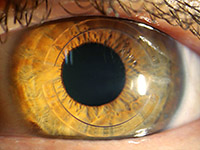KERATOCONUS
General Description
 Keratoconus is an asymmetric and bilateral degenerative disease of the cornea, which is the lens of the eye. This pathology is characterized by a decrease in visual sharpness which cannot be corrected with prescription lenses. People with the condition generally present very short vision and one eye that is more affected than the other. This condition can occur at any age but is more frequently seen in adolescence, when it becomes more pronounced.
Keratoconus is an asymmetric and bilateral degenerative disease of the cornea, which is the lens of the eye. This pathology is characterized by a decrease in visual sharpness which cannot be corrected with prescription lenses. People with the condition generally present very short vision and one eye that is more affected than the other. This condition can occur at any age but is more frequently seen in adolescence, when it becomes more pronounced.
Keratoconus occurs in varying degrees ranging from slight manifestations such as myopias to severe cases of corneal deformity which can even cause ruptures. These ruptures are seen as white spots in the cornea.
Causes
Keratoconus is commonly seen in people who have had chronic allergic conjunctivitis during childhood. It is thought that the trauma produced by continuous eye rubbing creates an alteration in the normal anatomical structure of the cornea and results in progressive loss of vision in adolescence.
It is also possible to see keratoconus in familiar groups, or isolated cases caused by gene mutations.
Benefits of treatment:
Keratoconus can be treated in several different ways depending on the severity of the disease:
- Eyeglasses
- Rigid contact lenses
- Intracorneal Ring
- Cornea Transplant
Technical description of surgery:
Intracorneal rings or Ferrara’s Rings The ring(s) are one or two annular segments of different graduations depending on the degree of the cone to treat. The ring(s) is placed in the cornea with the purpose of modifying the shape of the cone. The result is a more rounded or spherical form, similar to the shape of a normal cornea. When this is achieved, visual sharpness improves.
The ring(s) are one or two annular segments of different graduations depending on the degree of the cone to treat. The ring(s) is placed in the cornea with the purpose of modifying the shape of the cone. The result is a more rounded or spherical form, similar to the shape of a normal cornea. When this is achieved, visual sharpness improves.
This technique has the advantage of being reversible and also allows the possibility of changing the ring to another graduation depending on the final graduation and the patient’s satisfaction.
ClĂnica 20/20 has recently acquired an Intralase laser (ILASIK registered trademark) This femtosecond laser can further improve the process of implantation of the Ferrara Rings, leading to even better results.
A transplant is the last resource for the treatment of Keratoconus as it implies the use of a donor’s cornea.
In recent years, refined sutures and instruments, as well as sophisticated operating microscopes have significantly improved the prognosis in all patients requiring corneal transplants.
It is important to consider that when a foreign tissue is implanted, there is the possibility of rejection. The recovery time involves several months and the transplant is non-reversible. If necessary a new transplant would be required. This surgery is generally reserved for very advanced Keratoconus in which the cornea has lost its transparency.
Hospitalization
Not necessary.
Preparation time10 minutes
Length of surgeryIntracorneal Ring: 20 minutes | Corneal transplant: 1 hour
Recovery timeIntracorneal Ring: 1 to 3 months | Corneal transplant: 6 months to 1 year.
